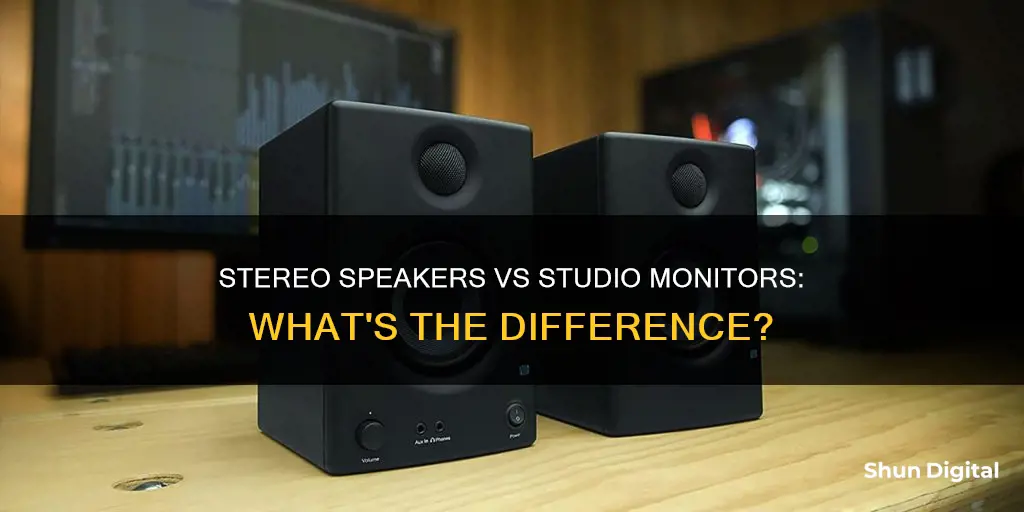
Studio monitors and stereo speakers may look similar, but they are designed for different purposes and behave differently. Stereo speakers are designed for entertainment and listening pleasure, while studio monitors are meant for critical listening and music production. Stereo speakers often use frequency manipulation to enhance the listening experience, whereas studio monitors aim to reproduce audio in a transparent and neutral manner, presenting the pure and unadulterated version of the audio signal. Studio monitors are also active speakers, meaning they have built-in amplifiers, while most stereo speakers are passive and require external power.
| Characteristics | Values |
|---|---|
| Purpose | Stereo speakers are designed for entertainment and listening pleasure. Studio monitors are designed for critical listening and music production. |
| Sound | Stereo speakers use frequency manipulation to enhance the listening experience. Studio monitors aim for a flat, precise sound, presenting the audio signal in its pure and unadulterated form. |
| Active/Passive | Stereo speakers are generally passive, receiving power from a dedicated standalone amplifier. Studio monitors are active speakers with built-in power amplifiers. |
| Power Amplifiers | Studio monitors have multiple power amplifiers in one unit, powering each speaker cone individually for a more precise sound. |
| Crossovers | Studio monitors use crossovers to split frequencies and ensure they go to the right speaker, adding clarity and precision. |
| Nearfield | Studio monitors are designed for nearfield use, meaning they are placed close to the listener to assess mixes with clarity and accuracy. Stereo speakers are designed for midfield use, producing the best sound quality when the listener is positioned a few metres away. |
| Engineering | Studio monitors require intricate engineering and rigorous testing to ensure a flat, linear frequency response and reduce undesirable artifacts. Stereo speakers may not require the same level of engineering complexity. |
| Cost | Studio monitors are generally more expensive due to intricate engineering, premium components, and quality control measures. Stereo speakers may be more affordable. |
What You'll Learn
- Studio monitors are designed for critical listening and music production
- Stereo speakers are designed for entertainment and listening pleasure
- Studio monitors are active speakers with built-in amplifiers
- Stereo speakers are passive and require external power
- Studio monitors are intended for nearfield use

Studio monitors are designed for critical listening and music production
The active configuration of studio monitors also enables built-in signal processing capabilities, allowing for precise calibration and equalisation to achieve a flat frequency response. This results in a cohesive, integrated audio system with utmost efficiency and fidelity. Studio monitors are designed for nearfield use, with speakers placed close to the listener to assess mixes with clarity and accuracy. This reduces the impact of room acoustics and enables confident, critical decisions.
The intricate engineering of studio monitors ensures a consistent and reliable performance, producing a flat, linear frequency response across the audible spectrum. Each component is carefully selected and optimised to achieve sonic purity and accuracy, reducing undesirable artifacts such as resonance, distortion, and phase anomalies. This design maintains a transparent, uncoloured sound signature, accurately reproducing the source material. Studio monitors are, therefore, essential tools for engineers, producers, and audiophiles who require unmatched accuracy and transparency in sound reproduction.
Studio monitors are particularly useful for critical listening tasks such as analysing frequency balance, evaluating harmonic balance, and adjusting spatial imaging. They provide an accurate impression of the mix, allowing users to easily identify imperfections. This level of detail is crucial in music production, where the authenticity of the source material is of utmost importance. Studio monitors enable professionals to make informed decisions and create high-quality audio productions.
In summary, studio monitors are designed with specific features and engineering to facilitate critical listening and music production. Their flat frequency response, active configuration, nearfield use, and sophisticated engineering make them ideal for revealing nuances and imperfections in audio recordings. Studio monitors are, therefore, indispensable tools for professionals seeking accuracy, transparency, and precision in their audio work.
Identifying Your Monitor: 16:9 Aspect Ratio Detection
You may want to see also

Stereo speakers are designed for entertainment and listening pleasure
Powered speakers are designed to fill a room with sound and are a good choice for those who want sound options and enjoy music listening and enhancement. They are also a good option for content creators and video editors, as they can fulfil their audio needs without requiring intense scrutiny.
Stereo speakers are designed to provide the best sound quality when the listener is positioned in the midfield. This means that if you are too close to a stereo speaker or too far from a studio monitor, the sound quality will be significantly different.
Stereo speakers are also more accessible to regular music lovers, as studio monitors tend to be geared towards professionals due to their intricate engineering and pro-level intricacies. Stereo speakers are a good choice for those looking for a speaker system for entertainment purposes.
Ankle Monitors: Buzzing or Silent?
You may want to see also

Studio monitors are active speakers with built-in amplifiers
Firstly, it allows manufacturers to have greater control over the audio signal path, minimising signal degradation and optimising performance. Additionally, the built-in amplifiers in studio monitors enable more precise sound reproduction. This is achieved by powering each driver (woofer, midrange, and tweeter) individually, resulting in a more accurate and detailed sound output.
The presence of built-in amplifiers also contributes to the overall cohesive and integrated audio system of studio monitors. By calibrating and equalising precisely, studio monitors can achieve a flat frequency response. This means that the output signal remains as close as possible to the input signal, without any boost or change in pitch, tone, or amplitude.
Furthermore, the built-in amplifiers in studio monitors enable them to focus audio waves on a nearfield, which is a smaller and more controlled listening area. This nearfield monitoring ensures that the sound is directed towards the listener's ears, reducing the impact of room acoustics and providing a clear and immediate sound experience.
In summary, the built-in amplifiers in studio monitors are essential for their functionality, performance, and ability to deliver accurate and detailed sound reproduction. This active design sets them apart from passive home stereo speakers and makes them a valuable tool for professionals in audio engineering, music production, and critical listening applications.
Optimize Wix Page Sizing for All Monitors
You may want to see also

Stereo speakers are passive and require external power
Stereo speakers are passive and require an external power source to function. This means they need an amplifier to drive the audio signal, which is typically provided by a standalone amplifier or receiver. In contrast, studio monitors are active speakers with built-in power amplifiers, allowing them to amplify the audio signal directly. This active configuration offers greater control over the audio signal path, minimising signal degradation and optimising performance.
The passive design of stereo speakers means that they rely on external power to function. This external power is typically provided by an amplifier or receiver, which connects to the speakers via audio input connections. This setup is common in home audio systems, where the amplifier or receiver is often placed in a central location, such as a rack or shelf, and connected to multiple speakers throughout the room.
The advantage of passive speakers is their flexibility. They can be easily connected to a variety of amplifiers or receivers, allowing users to upgrade or replace components as needed. This makes them a popular choice for home audio enthusiasts who want the freedom to customise their system. Additionally, passive speakers often provide a wider range of connectivity options, such as RCA, optical, and coaxial inputs, making them compatible with a variety of audio sources.
However, the external power requirement of passive speakers can also be a drawback. It means that stereo speakers typically require more components and connections, which can make setup and maintenance more complex. The need for an external amplifier also adds to the overall cost of the audio system.
In summary, the passive nature of stereo speakers means that they require external power to function. This external power is provided by a separate amplifier or receiver, which connects to the speakers via audio input connections. This setup is common in home audio systems and offers flexibility in terms of customisation and connectivity. However, it also adds complexity and cost to the overall audio system.
Monitor Refresh Rates: Finding Your Hertz
You may want to see also

Studio monitors are intended for nearfield use
Studio monitors are intended for near-field use, meaning they are designed to be placed close to the listener, usually within arm's reach. This is in contrast to home stereo speakers, which are typically designed for midfield or far-field use, where the listener is positioned at a greater distance from the speakers.
The near-field design of studio monitors has several advantages. Firstly, it allows for a more direct and precise sound, as the speakers are focused on a smaller field, making it easier to maintain audio purity. This is crucial for critical listening and music production, as it enables engineers and producers to detect even the slightest nuances and imperfections in their recordings. The close listening distance also reduces the impact of room acoustics and other variables, providing a clear and immediate sound that allows for confident and accurate decision-making.
Additionally, the near-field nature of studio monitors means they are well-suited for smaller spaces, such as bedrooms, studios, and other confined areas. They are designed to prevent the room from enhancing or reducing the true frequency of the sound, ensuring a consistent and accurate listening experience. This makes them ideal for mixing, editing, and mastering audio to a professional standard.
The near-field design also contributes to the overall accuracy and transparency of studio monitors. By minimising the distance between the listener and the speakers, studio monitors provide a more direct path for the sound waves to travel, reducing the potential for distortion or alteration. This results in a more accurate representation of the audio signal, which is crucial for applications where sound reproduction must be as neutral and unadulterated as possible.
In summary, the near-field design of studio monitors is a key factor in their ability to deliver precise, consistent, and accurate sound reproduction. This makes them indispensable tools for professionals in audio production, engineering, and critical listening environments.
CO2 Monitor Buying Guide: Where to Purchase
You may want to see also
Frequently asked questions
Stereo speakers are designed to enhance the listening experience by using frequency manipulation. Studio monitors, on the other hand, aim to reproduce audio in a transparent and neutral manner, presenting the pure and unadulterated version of the audio signal. Studio monitors are intended to produce a flat frequency response to play back the audio recording as intended without any coloration to the sound.
Stereo speakers are designed for entertainment and listening pleasure. Studio monitors, however, are designed for critical listening and music production, where the accuracy and transparency of the audio reproduction are crucial. Studio monitors are often used in recording, mixing, and mastering processes to unveil imperfections and make necessary adjustments.
Stereo speakers typically use a passive design, requiring an external amplifier to drive the audio signal. Studio monitors, on the other hand, are usually active speakers with built-in amplification. They also tend to have multiple power amplifiers in one unit, allowing individual power for the woofer (bass), midrange, and tweeter (treble) cones, resulting in a more precise sound.
Stereo speakers are designed to project sound throughout a room and are ideal for larger spaces. Studio monitors, on the other hand, are crafted for short distances and smaller areas, such as bedrooms, studios, and enclosed spaces. They prevent the room from enhancing or reducing the true frequency of each sound.







